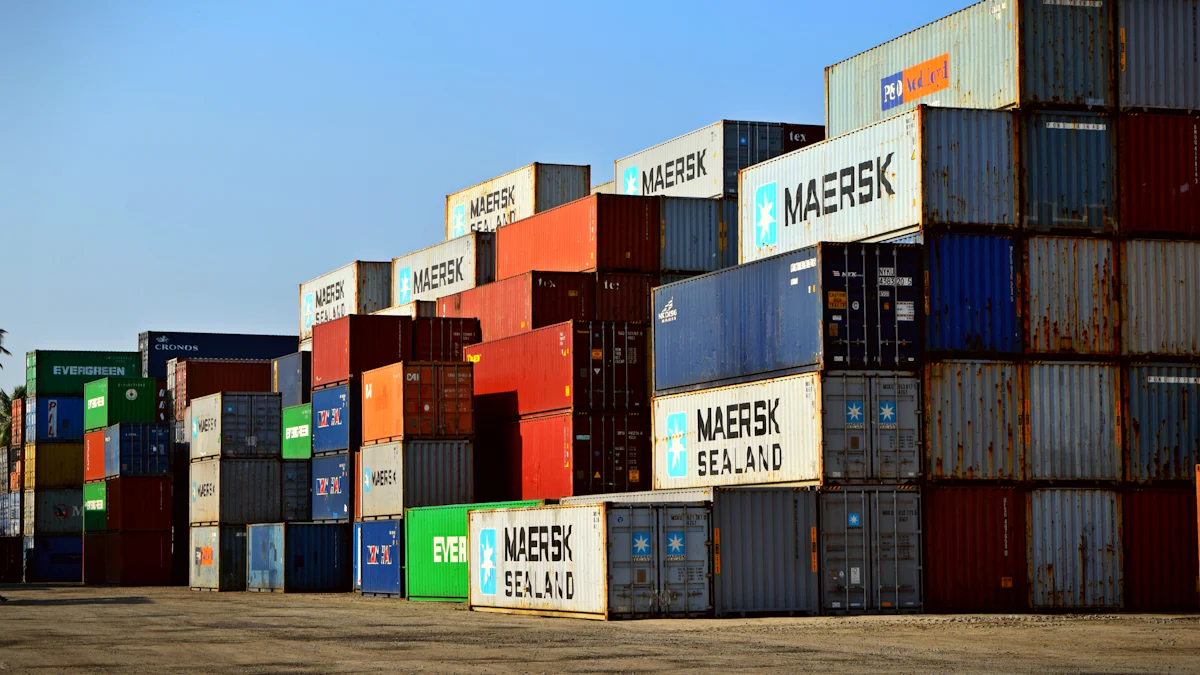Mastering Agility and Resilience for Modern Logistics

Agility and resilience have become essential for navigating the ever-changing logistics industry. Businesses that adapt quickly recover faster and often outperform competitors. Challenges like labor shortages, trade conflicts, and environmental regulations demand flexible solutions. How can you ensure your operations remain agile and resilient in such a dynamic environment?
Key Takeaways
Agility in logistics means changing fast with market needs. Stay flexible and quick to meet what customers want.
Resilience means being ready for problems and bouncing back fast. Use plans and tools to spot risks and keep working.
Use digital tools like JusLink to make supply chains better. These tools give live updates and help teams work together well.
Defining Agility and Resilience in the Logistics Industry

The Role of Agility in Modern Supply Chains
Agility in the supply chain means adapting quickly to changing market conditions. It focuses on responsiveness and flexibility rather than just cutting costs. You can think of it as the ability to anticipate shifts in demand and adjust inventory or operations accordingly.
Industry experts define supply chain agility as:
The ability to adapt efficiently to market changes.
A focus on responsiveness over cost reduction.
Managing inventory effectively while responding to demand shifts.
Agility allows you to switch sourcing, manufacturing, or distribution methods seamlessly. For example, if a supplier faces delays, an agile supply chain lets you pivot to another supplier without disrupting customer service. This adaptability ensures you can navigate disruptions while maintaining profitability.
Understanding Resilience in Logistics Operations
Resilience in logistics is about preparing for and recovering from disruptions. It involves having the right tools, processes, and people to identify risks and respond effectively.
Resilient operations rely on business intelligence to spot threats early.
They use resources to test new technologies and adapt to market needs.
Employees play a key role by staying open to change and following leadership direction.
Resilience also includes proactive measures like diversifying suppliers or using digital tools like AI to predict disruptions. These strategies help you maintain continuity even in volatile environments.
Why Resilience and Agility Are Key to Success
Resilience and agility are critical for thriving in today’s logistics landscape. Companies that embrace these qualities often outperform competitors. According to McKinsey, resilient organizations can achieve up to a 50% higher shareholder return.
Benefits of agility include:
Improved customer satisfaction by meeting expectations.
Enhanced risk management through disruption prediction.
Increased efficiency by reducing lead times.
By combining resilience and agility, you can align your operations with market demands and stay competitive in a rapidly evolving industry.
Challenges Impacting Agility and Resilience in the Supply Chain
Economic Disruptions and Market Volatility
Economic disruptions can significantly impact supply chain agility. You face challenges like fluctuating fuel prices, rising transportation costs, and shifting trade regulations. These factors make it harder to maintain a balance between cost efficiency and operational flexibility.
To navigate these disruptions, you can adopt strategies like forming strategic partnerships with suppliers. These partnerships improve visibility and control over your supply chain. Monitoring free trade agreements also helps you identify competitive locations for operations. Additionally, government initiatives, such as customs clearance improvements, can reduce operational constraints and support businesses during volatile periods.
Price flexibility is another effective measure. It prevents price gouging and ensures fair pricing during economic uncertainty. Supporting struggling businesses within your network can also help maintain operations despite rising input costs.
Tip: Staying proactive in monitoring economic trends can help you adapt quickly and maintain a resilient supply chain.
Supply Chain Bottlenecks and Inefficiencies
Bottlenecks disrupt supply chain resilience and agility by slowing down operations. These bottlenecks often arise from external factors like pandemics, political instability, or natural disasters. Internal challenges, such as poor inventory management or insufficient capacity, also contribute to inefficiencies.
Cause Type | Examples |
|---|---|
External Factors | Pandemics, political instability, economic downturns, natural disasters |
Internal Challenges | Ineffective inventory management, lack of communication, insufficient capacity |
Labor shortages, carrier disruptions, and trade restrictions further complicate the situation. These issues reduce your ability to respond quickly to market demands. Addressing these bottlenecks requires improving communication, optimizing inventory management, and investing in scalable solutions.
Adapting to Unpredictable Demand and Customer Expectations
Unpredictable demand and evolving customer expectations challenge your ability to maintain supply chain agility. Customers now expect faster deliveries, real-time tracking, and personalized services. Meeting these demands requires a combination of visibility, communication, and technology.
Improve visibility across your supply chain to anticipate demand fluctuations.
Communicate effectively with suppliers and stakeholders to ensure alignment.
Implement cloud-based technology for real-time tracking and inventory management.
By adopting these strategies, you can create a resilient supply chain that adapts to market changes while meeting customer needs.
Note: Investing in advanced tools like JusLink can enhance your ability to predict demand and manage inventory efficiently.
Strategies for Building Resilience and Agility in Logistics

Leveraging JusLink for Digital Transformation
Digital transformation plays a critical role in enhancing agility in logistics. Tools like JusLink integrate advanced technologies such as AI and IoT to improve supply chain performance. These tools allow you to respond quickly to market changes and disruptions. JusLink’s predictive analytics provide real-time insights into delays or rerouted shipments, enabling you to manage logistics complexities effectively.
By adopting JusLink, you can streamline supply chain planning and operations. Its intelligent risk management system helps you identify supply chain risks early, ensuring proactive responses. The platform also fosters cross-functional collaboration, improving visibility across transportation and logistics networks. This integration of digital tools creates room for experimentation, allowing you to test innovative strategies without disrupting operations.
Enhancing Data Visibility and Collaboration with JUSDA
Data visibility is essential for a resilient supply chain. JUSDA’s solutions provide real-time data access, enabling you to detect and resolve issues like shipping delays quickly. Improved visibility enhances collaboration among stakeholders, ensuring better communication and decision-making.
With JUSDA, you gain comprehensive insights into orders and inventory. This helps you understand the impact of delays and adjust operations accordingly. Real-time data fosters collaboration between organizations, allowing you to address challenges collectively. By leveraging these tools, you can maintain a resilient supply chain while meeting customer expectations.
Proactive Risk Management and Contingency Planning
Effective risk management is vital for building resilience and agility. You can adopt strategies like demand forecasting to predict market needs accurately. Diversifying suppliers and transportation modes reduces risks associated with disruptions.
Using technology and data analytics, you can monitor supply chain risks in real time. Collaboration with stakeholders ensures that everyone is prepared for potential challenges. Scenario planning allows you to prepare for various disruptions, ensuring business continuity. Proactive risk management not only minimizes losses but also enhances operational efficiency and customer trust.
Embracing Innovation to Strengthen the Supply Chain
Innovation is key to staying competitive in transportation and logistics. Technologies like AI, warehouse robotics, and self-driving trucks improve supply chain agility. AI enhances forecasting accuracy and automates repetitive tasks, while robotics streamline order fulfillment.
Investing in innovation strengthens your supply chain by addressing challenges like labor shortages and delivery inefficiencies. Modern technologies also improve supply chain security, protecting against cyber threats. By embracing innovation, you can create a flexible logistics network capable of adapting to market changes.
Tip: Continuous improvement and room for experimentation are essential for fostering innovation in logistics.
Practical Tips for Staying Competitive in the Logistics Industry
Continuous Improvement and Workforce Development
Continuous improvement is essential for maintaining a competitive edge in the logistics industry. By identifying inefficiencies and implementing targeted initiatives, you can enhance supply chain performance and reduce costs.
Initiative | Description | Outcome |
|---|---|---|
Eliminate avoidable accessorials | Focus on reducing unnecessary logistics costs. | Saved a food distributor approximately $85,000 annually. |
Streamline communication | Improve coordination among stakeholders in USDA shipments. | Reduced email volume and minimized day-of delivery issues. |
Improve operational efficiency | Enhance scheduling and pickup processes. | Decreased month-over-month accessorial spend for USDA orders by 84.81%. |
Workforce development also plays a critical role. Equip your team with the skills needed to adapt to changes in transportation and logistics. Encourage continuous learning and foster a culture of innovation. This approach ensures your workforce remains prepared for future challenges, enhancing business resilience.
Monitoring Trends and Adapting Quickly
Staying informed about industry trends helps you anticipate changes and maintain supply chain agility. Key trends shaping the logistics industry include:
Advancements in automation, such as robotics and AI for warehouse operations.
Integration of IoT for real-time monitoring and data visibility.
The rise of everything-as-a-service (XaaS) for flexible logistics solutions.
Increased demand for real-time data and supply chain transparency.
By monitoring these trends, you can identify opportunities for innovation and adjust your strategies accordingly. This proactive approach strengthens your ability to build a resilient supply chain and meet evolving customer expectations.
Investing in Advanced Tools like JusLink
Digital tools like JusLink are transforming the logistics industry by enhancing supply chain planning and operations. JusLink’s AI-driven forecasting and intelligent risk management features improve supply chain agility. These tools provide real-time insights, enabling you to address disruptions swiftly and maintain supply chain performance.
Investing in JusLink also fosters collaboration across your transportation and logistics networks. Its automated management features streamline operations, creating room for experimentation and innovation. By leveraging such advanced tools, you can enhance business resilience and stay ahead in a competitive market.
Tip: Prioritize tools that offer scalability and customization to meet your unique logistics needs.

JUSDA Solutions
To provide you with professional solutions and quotations.
Agility and resilience are essential for overcoming challenges in logistics. Tools like JusLink enhance adaptability by providing real-time insights and fostering collaboration. A connected supply chain reduces costs and improves delivery performance. Promote open communication and continuous learning to prepare for changes in transportation and logistics. Stay proactive to thrive in this dynamic industry.
See Also
Transforming Future Logistics With AI Supply Chain Solutions
Mastering Lean Logistics For Success In High-Tech Manufacturing
Jusda: Your Guide To Achieving Supply Chain Resilience
Boosting Warehouse Efficiency With Advanced Logistics Robotics
Transforming Logistics Through Innovative Supply Chain Strategies
